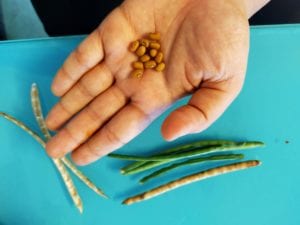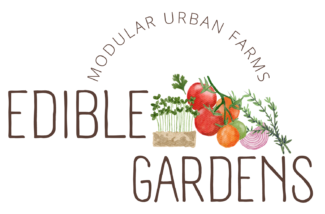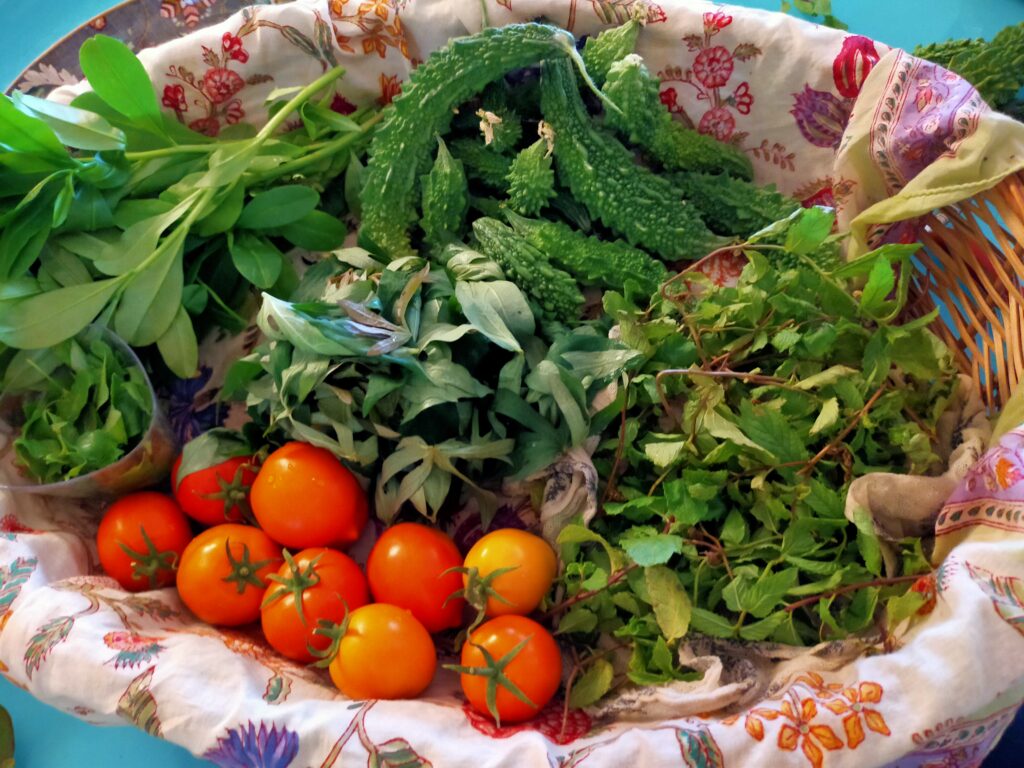I used to think that to grow food, I’d need a large farm. Or if not a farm, then at least a big enough space on the ground.
The idea of being able to grow food, edible plants, vegetables and medicinal and herbs in a small space like a balcony or a box grill outside a balcony was absolutely impossible. But then I don’t own a farm, or a large backyard or lawn. So, should I let that have stopped me from trying?
The answer to that is a very clear no. Experimenting is the best way to know if a stereotype can be broken or not and that’s exactly what I did. I started experimenting, growing plants in pots of 6 inches, 8 inches and 12 inches. I started sowing seeds of herbs like basil, cuttings like mint and seeds like tomatoes and chilies. I celebrated my successes when I saw the first of my tomatoes arrive, I learnt from my failures when my brinjals took more than 2 years to start fruiting! And my experiments of over the last ten years trying to grow edible plants in box grills outside my windows have taught me that all it takes is time, to observe and learn and implement.
This post about 11 ways to set up a kitchen garden in your flat in Mumbai is a synopsis of my learnings over the years and I’m so happy to be finally sharing them with you!
Gardening is one of the most meditative activities I have ever experienced, and I cannot even begin to tell you how fulfilling it is to be able to harvest my own food.

1. Start with Looking for Light
Edible plants usually require some amount of sunlight. So, look for spaces around you that have some amount of sunlight or daylight reaching in. There are artificial lights too available in the market that are used for indoor farming but for the purpose of this post, let’s understand the best way to use ambient light and sunlight. Once you’ve identified where you want to setup your edible garden, it could be at your home, your school, your college, office, etc. the next step you need to take is to study the amount of sunlight around. Study the number of hours that the sun’s rays reach your windows, balconies and so on; all through the day and note it down in a garden journal. Even better, you can sketch out each of the spaces you have in mind, the direction of the sunlight – is it coming in from the East, West, North or South and so on. Once you’ve collected this data, list out the number of hours each of the spaces receives. This will go a long way in helping you identify which plants you will keep in which spot for best results. I’ve shared a list of all the varieties of plants you can consider growing and the amount of sunlight each of them will require.
2. Choose the Right Pot Size
In the excitement of setting up a garden, we often tend to forget this small but super important factor. And it is especially more important in the case of an edible garden, as the size of the pot will factor in while determining harvest quantities. It’s a good idea to understand this aspect as well. In each of the ideas below, I’ve shared the minimum size of the container or pot you’ll need for each variety of plant you want to grow.
3. Start A Herb Garden
Whether you’re new to growing your own food or want to expand your existing herb garden, starting small is probably your best option. Starting small is also a good idea as you can perform several mini tests in all the small spaces you have around your home – your kitchen window or shelf near the window, your living room windows or box grill, a specific corner of your balcony, etc. You can always expand your herb garden space as you need it but starting small is much easier to manage and you can also see a lot of success with a small space. This also gives you the opportunity to care for a wide variety of plants, including some hard-to-find varieties, like spearmint for example. Some of the best small-space herb gardens are those that are container-based, which allow you to move your plants around as needed. So, if you have a small space like a windowsill, you can start herb garden. Most window boxes can fit a small herb garden.
A herb garden is a great space to grow fresh, aromatic herbs for cooking and seasoning. You can grow just about any herb in a herb garden, from oregano to parsley, basil, thyme, coriander, and more, all without needing a large space. If you want to grow more than just a few herbs, you can expand your herb garden to include other plants too. This is a great way to get fresh herbs for your cooking and also to cut down on your grocery shopping.
Most herbs can be easily grown in a 5-inch container or pot. Herbs grow like small bushes and don’t require as much space as other plants and their root systems also don’t need as much depth, so a five-to-six-inch pot will be more than enough for herbs like basil, mint, oregano, etc. And they also don’t need too much sunlight, just about 2 hours of sunlight is enough to keep them growing happily. So, you can look at growing at least about three to four varieties of herbs in a small space like your kitchen window ledge or grill.
Growing and harvesting your own fresh herbs is a great way to add natural flavours to your meals. So if you have a small space, consider starting with a herb garden. You can use small pots, upcycle curd tubs or even hanging containers to grow small amounts of herbs. When the plants are large enough to harvest, you can use them to flavour your recipes or add them to your salads and dips or you can bring them indoors, dry them and make a fragrant potpourri for your cabinets too.

4. Grow Plants That Climb and Creep
Some of the most popular and space-efficient plants for small spaces are those that climb up a wall or even a grill. This type of plant requires very little space and can produce a lot of food for a small space. You can also use trellis designs for creeper plants to add more uses to smaller spaces.
Many small spaces in Mumbai such as balconies, windows, and terraces can be used to grow edible plants that creep and climb. One of the easiest and most cost-effective ways to create an edible garden is to use plants that climb up a wall or grill. These plants occupy very little space but can produce a lot of food. Some common edible climbers are bitter gourd, cucumber, beans and some varieties of spinach.
Plant climbers and creeper plants in containers using different trellis designs around the open spaces like windows, balconies or terraces to get a diverse edible landscape around your home. You can use hooks on ceilings and attach ropes across the hooks to create a flexible trellis for the plants to climb up. This is a cost effective and easy way to set up trellises in case you don’t have the budget to buy a readymade trellis for your climbing edible plants.
Growing your own food, whether you are in a small apartment or a big house, is an excellent way to save energy, reduce your ecological impact, and reconnect to the land. You can grow food year-round, no matter where you live.
My ultimate favourite thing about growing climbers and creepers in and around my compact garden in Mumbai is that I can use all the space that’s beyond my arm’s reach! After the climbers cross about 4-5’ height and begin to hold on to the trellis, they also begin to harvest sunlight better, and this helps them grow into healthier plants and give better harvests.

5. Don’t Forget Those Microgreens
Microgreens have become quite a popular part of international cuisine. When you visit a restaurant of repute, you’ll typically find a few tiny green leaves adorning your dishes, even desserts for that matter! These little greens that are such a favourite topping are actually very easy to grow in your own home. They have become a way to add a pop of colour to your plate. But not everyone knows that you can grow microgreens easily in your own home. You can grow microgreens in any space with limited sunlight and soil, which makes them ideal for apartment dwellers and those with small spaces. You can even grow microgreens in hanging planters in case you don’t have space to keep the microgreen pots or trays.
These greens are very small in size and are characterised by their bright green colour and strong, fresh flavour. They are an excellent source of vitamins, minerals, and antioxidants, and have been shown to help improve memory and reduce age-related cognitive decline.
Growing microgreens gives you the option to add them to your salads or smoothies daily or enjoy them as a side dish too. So with a little bit of know-how and some small space gardening tricks, you too can grow your own microgreens to add to your meals.

6. Leafy Green Veggies Occupy Very Little Space
Growing leafy green vegetables in small spaces is a great idea for your compact edible garden. In just about a ten-to-twelve-inch size pot, you can grow a variety of leafy greens like Spinach, Arugula, Lettuce, Bok choy and more. Not only does this provide you with fresh produce, but it also allows you to harvest your crops when they are young and tender rather than having to harvest the entire plant when it is mature and tough. This allows you to use less soil and space in your garden, which makes it much easier to maintain.
I love to go to my garden and harvest these super fresh greens for my meals, for example an arugula cheese and tomato sandwich or a spinach omelet or a kang kong and bean stir fry! If you’re short on space, or just starting out, a leafy container garden can help you get the most out of your edible space.
 7. Look at Growing Short Seasonal Plants
7. Look at Growing Short Seasonal Plants
When you have a compact garden space, you naturally want to maximise every square foot. by growing plants that are fast growing and yield a quick harvest, you are about to grow a larger variety of edible plants and harvest veggies much more quickly. Beans for example can give you harvests within 30 days of planting. Peanuts will give you harvests within 45 days. Tomatoes will begin to give you harvests within 60 days and so on. Plants that take a longer time to grow and yield harvest after a longer gestation period or are not currently in their fruiting season end up staying in your little garden for longer periods of time, occupy unnecessary space and will test your patience for sure! Also, it is important to understand your growing climate and changing seasons to know which variety of plant will be best suited for your growing. For example, tomatoes are ideally sown in a hot season, and they begin yielding harvests at the onset of the cooler season (when the difference between day and night temperatures is greater than 10 degrees) so you want to be sure to design your planting space and schedule according to the harvest time and season.

8. Grow a Lot of Shrubs
Here are a few small fruiting shrubs you could consider for your edible space: chilis, eggplants, tomatoes. These are great for providing large amounts of fruit for a small space and are also easy to grow. If you want to focus your edible gardening efforts on medium sized plants that are easy to grow in small spaces, make sure to include shrubs and a couple of medium stocked plants. This will help to add extra foliage and shade over your other crops, which will help to increase their yields and make your space feel a lot more immersive and biodiverse.
Chilies, tomatoes and brinjals will happily grow in 12–14-inch pots or in a small, raised bed. Tomatoes can grow into medium-sized climbers but that can be managed by incorporating a bamboo or metal trellis within the pot. Look at growing tomatoes from September till April in Mumbai, that’s the ideal season. Chilies and brinjals are easy to grow throughout the year in Mumbai weather.
You can also look at growing root vegetables in your compact edible garden. This includes beetroot, carrot, raddish, turnip and more.Add to this all the brassicas like cabbage, broccoli and cauliflower, again you can grow these in a 10-12 inch size pot. Both the root veggies and the brassicas can be grown from September to March as they require a cool climate to grow well and flower.
9. Stacking Functions – Multiple Plants in one pot
A hack for compact garden spaces is to stack them all up! What does that mean? In my garden for example, the south and east facing box grill has the most stable amount of sunlight with the least amount of strong winds. So I keep pots in a stacked manner such that the biggest pot – about 20-22 inch in size with the tallest plant kept at the bottom. Then on top of the same big pot, I keep a medium sized pot – about 14 inch in size with a herb or a shrub plant. If this plant was kept at the bottom, it would spend its energy trying to get sunlight and end up growing leaner and taller and not develop the canopy I want it to. So it is best to keep it at a higher level and on the base of the bigger pot so that that space is utilised as well as the shrub – a chili for example is happy in its sunny spot. And on top of this, I’d keep a pot that’s about 6-7 inches in size with a herb or a medical plant in it. This helps you maximise a compact space perfectly as well as creates a microclimate for all the three varieties of plants in that space.
10. The Key to Watering Correctly and Mulching
The first thing you need to do to ensure good plant health is to learn how to water your plants correctly. While it may seem obvious, many novice gardeners tend to water their plants too often. This is bad for plant health, as it causes root rot and results in leaching nutrients out of the soil rather than bringing them in. A good rule of thumb you could follow is water your plants when they are only half-dry, which is when you can gently squeeze the soil around the plant, and it shows you a little amount of water present. Another excellent practice is to mulch around your plants. Mulching is the act of ensuring that the soil around your plant is covered at all times. You can mulch the soil around your plants using stones, eggshells, pista shells, cardboard, dry leaves, cocopeat and so on.

11. Watch Out for These Pests
Gardeners are usually gentle folk but when it comes to pests, we can become quite aggressive and distraught! Just knowing the most common, annoying pests then goes a long way in keeping yourself calm and your plants happy, pest free.
Sucking pests like aphids and mealybugs are some of the most common. They tend to feed on the sap of the plants, draining their essence and slowly killing them. There are also leaf eaters like loopers that are quite common on herbs and stink bugs that are the bane of our existence and just decimate gourd plants! The quickest way to deal with them is to regularly visit and observe your garden and the moment you see even a single one of them, just pick them up and throw them out from your garden. This is extremely crucial for compact gardens because if you let them be, they’ll quickly multiply and spread out to all your other plants. An excellent way to stop them from coming to your compact edible garden to begin with is to have a thick and biodiverse garden with a lot of strong smelling plants and bright coloured flowers. Most pests hate yellow flowers and can’t stand the smell of garlic and ajwain/ Indian borage for example. And if you are already under attack, a diluted soap-nut spray is the simplest solution you can use to spray these pests away. Please avoid neem solutions that are the go-to pest repellents in the market. Simply because neem solutions are not edible and you don’t want to coat your plants with it before harvesting.
So there you go, an exhaustive list of things you can do to setup and care for your edible garden. No matter how small or big your space, you can always grow a little something for you to harvest everyday. Please reach out to me for any specific questions you have about growing edible plants in your window, balcony or terrace garden in Mumbai.


